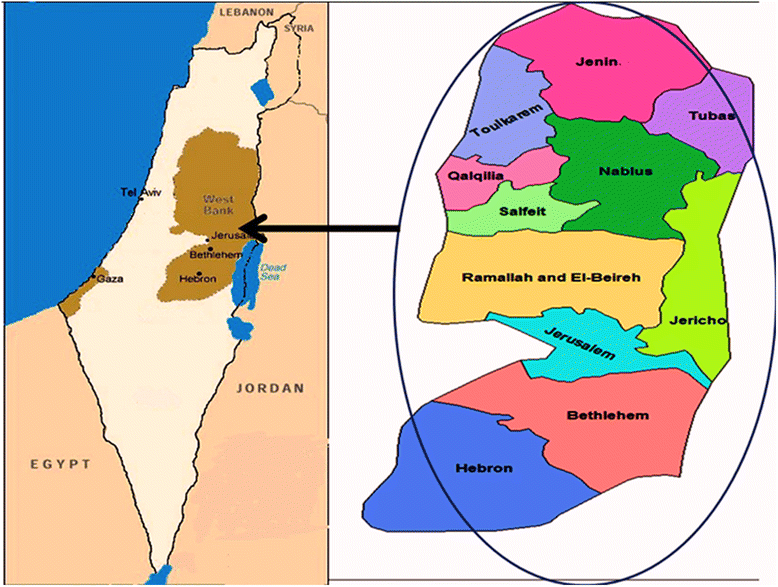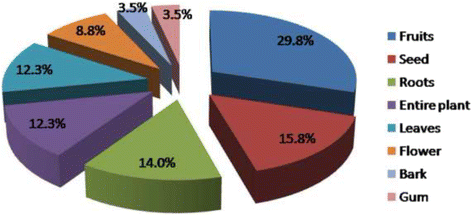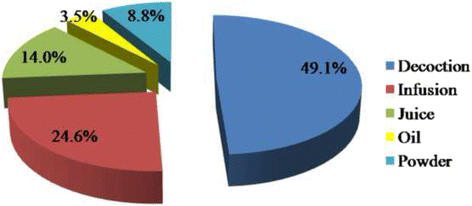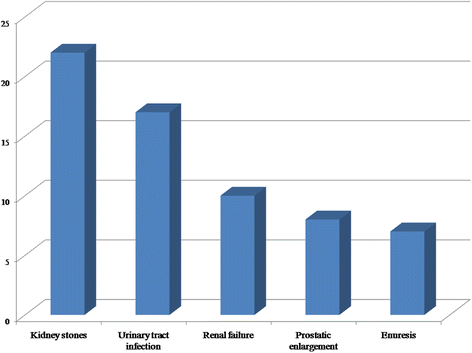Ethnopharmacological survey of medicinal plants practiced by traditional healers and herbalists for treatment of some urological diseases in the West Bank/Palestine
- PMID: 28482898
- PMCID: PMC5422913
- DOI: 10.1186/s12906-017-1758-4
Ethnopharmacological survey of medicinal plants practiced by traditional healers and herbalists for treatment of some urological diseases in the West Bank/Palestine
Abstract
Background: Throughout history, every civilization in the world used plants or their derivatives for treatment or prevention of diseases. In Palestine as in many other countries, herbal medicines are broadly used in the treatment of wide range of diseases including urological diseases. The main objective of this research is to study the use of herbal remedies by herbalists and traditional healers for treatment of various urological diseases in the West Bank regions of Palestine and to assess their efficacy and safety through the literature review of the most cited plants.
Method: The study included a survey part, plant identification and a review study. The first part was a cross-sectional descriptive study. Face to face questionnaires were distributed to 150 traditional healers and herbalist in all regions of the West Bank of Palestine. The literature review part was to assess the most cited plants for their efficacy and toxicity.
Results: One hundred forty four herbalists and traditional healers accepted to participate in this study which was conducted between March and April, 2016. The results showed that 57 plant species belonging to 30 families were used by herbalists and traditional healers for treatment of various urinary tract diseases in Palestine. Of these, Apiaceae family was the most prevalent. Paronychia argentea, Plantago ovata, Punica granatum, Taraxacum syriacum, Morus alba and Foeniculum vulgare were the most commonly used plant species in the treatment of kidney stones, while Capsella bursa-pastoris, Ammi visnaga and Ammi majus were the most recommended species for treatment of urinary tract infections and Portulaca oleracea used for renal failure. In addition Curcuma longa and Crocus sativus were used for enuresis while Juglans regia, Quercus infectoria, Sambucus ebulus and Zea mays were used for treatment symptoms of benign prostate hyperplasia. Fruits were the most common parts used, and a decoction was the most commonly used method of preparation. Through literature review, it was found that Paronychia argentea has a low hemolytic effect and contains oxalic acid and nitrate. Therefore, it could be harmful to renal failure patients, also Juglans regia, Quercus infectoria and, Sambucus ebulus are harmful plants and cannot be used for treatment of any disease.
Conclusions: Our data provided that ethnopharmacological flora in the West Bank regions of Palestine can be quite wealthy and diverse in the treatments of urinary tract diseases. Clinical trials and pharmacological tests are required evaluate safety and efficacy of these herbal remedies.
Keywords: Ethnopharmacology; Herbalists; Palestine; Traditional healers; Urological diseases.
Figures




Similar articles
-
Herbal remedies used for the treatment of infertility in males and females by traditional healers in the rural areas of the West Bank/Palestine.BMC Complement Altern Med. 2019 Jul 31;19(1):194. doi: 10.1186/s12906-019-2617-2. BMC Complement Altern Med. 2019. PMID: 31366346 Free PMC article.
-
Ethnopharmacological survey about medicinal plants utilized by herbalists and traditional practitioner healers for treatments of diarrhea in the West Bank/Palestine.J Ethnopharmacol. 2016 Apr 22;182:57-66. doi: 10.1016/j.jep.2016.02.013. Epub 2016 Feb 13. J Ethnopharmacol. 2016. PMID: 26883246
-
Ethnopharmacological survey of herbal remedies used for treatment of various types of cancer and their methods of preparations in the West Bank-Palestine.BMC Complement Altern Med. 2016 Mar 8;16:93. doi: 10.1186/s12906-016-1070-8. BMC Complement Altern Med. 2016. PMID: 26955822 Free PMC article.
-
Medicinal plants from Mali: Chemistry and biology.J Ethnopharmacol. 2015 Dec 24;176:429-37. doi: 10.1016/j.jep.2015.11.030. Epub 2015 Nov 18. J Ethnopharmacol. 2015. PMID: 26596257 Review.
-
Herbal remedies for urinary stones used in India and China: A review.J Ethnopharmacol. 2017 May 5;203:55-68. doi: 10.1016/j.jep.2017.03.038. Epub 2017 Mar 23. J Ethnopharmacol. 2017. PMID: 28344029 Review.
Cited by
-
Coconut oil rubbing as an easy and safe way to improve symptoms in primary nocturnal enuresis: A randomized double-blinded placebo-controlled clinical trial.Avicenna J Phytomed. 2022 Sep-Oct;12(5):449-456. doi: 10.22038/AJP.2022.20346. Avicenna J Phytomed. 2022. PMID: 36249458 Free PMC article.
-
Plumbagin inhibits fungal growth, HMGB1/LOX-1 pathway and inflammatory factors in A. fumigatus keratitis.Front Microbiol. 2024 Apr 9;15:1383509. doi: 10.3389/fmicb.2024.1383509. eCollection 2024. Front Microbiol. 2024. PMID: 38655086 Free PMC article.
-
Evaluation of an early twentieth century Afghan herbalist's preparations.Forensic Sci Med Pathol. 2019 Jun;15(2):314-318. doi: 10.1007/s12024-018-0027-2. Epub 2018 Sep 27. Forensic Sci Med Pathol. 2019. PMID: 30259392
-
Herbal remedies used for the treatment of infertility in males and females by traditional healers in the rural areas of the West Bank/Palestine.BMC Complement Altern Med. 2019 Jul 31;19(1):194. doi: 10.1186/s12906-019-2617-2. BMC Complement Altern Med. 2019. PMID: 31366346 Free PMC article.
-
Ca' Granda, Hortus simplicium: Restoring an Ancient Medicinal Garden of XV-XIX Century in Milan (Italy).Molecules. 2021 Nov 17;26(22):6933. doi: 10.3390/molecules26226933. Molecules. 2021. PMID: 34834025 Free PMC article.
References
-
- Bağcı Y. Ethnobotanical features of Aladağlar (Yahyalı, Kayseri) and its vicinity. Herb J Systc Bot. 2000;7:89–94.
-
- Saad B: Integrating traditional Greco-Arab and Islamic diet and herbal medicines in research and clinical practice. In: Phytotherapies: Efficacy, Safety, and Regulation. edn. United States: John Wiley & Sons, Inc.; 2015: 142–182.
MeSH terms
Substances
LinkOut - more resources
Full Text Sources
Other Literature Sources
Miscellaneous

